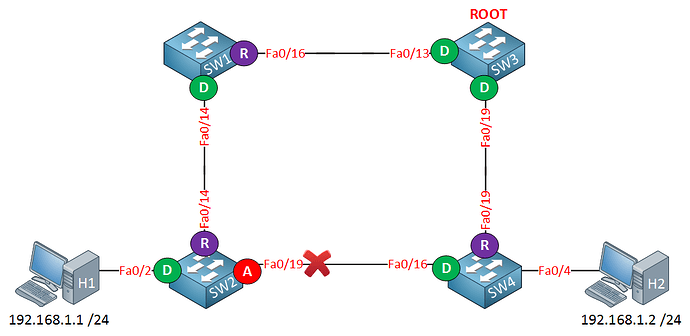STP - Aging time reduction with a TCN
When a topology change takes place on an STP topology, BPDUs are sent with the topology change (TC) flag set. This, among other things, causes the MAC address table aging timer to reduce from 300 seconds (which is the default) to 15 seconds.
This is done in order to flush out any stale MAC address entries that may be incorrect based on the new topology.
For example, take a look at this topology:

STP has chosen to block Fa0/19 on SW2. As frames are sent to and from our hosts, all switches will populate their MAC address tables. SW2 will have an entry for the MAC address of H2 (000c.29e2.03ba) like so:
Vlan Mac Address Type Ports ---- ----------- -------- ----- 1 000c.29e2.03ba DYNAMIC Fa0/14
So whenever H1 sends a frame destined for H2, SW2 will do a lookup in the MAC address table and will send that frame out of the Fa0/14 port.
Now imagine that the link between SW1 and SW3 fails. What happens then? The STP topology will reconverge, and the link between SW2 and SW4 will eventually remove the block and start operating. This may take up to 50 seconds for standard STP. This however is not a problem.
The problem is that entry in the MAC address table of SW2. Because of that, all frames sent from H1 to H2 will be forwarded out of the Fa0/14 port. This will be the case for 300 seconds (or five minutes) until the entry expires. Even after the STP topology reconverges and stabilizes 50 seconds later, SW2 will continue to send frames destined for H2 out of Fa0/14. When SW1 receives them, it will simply drop them.
Thus the aging time goes from 300s to 15s simply to quickly age out any entries that would cause such a behavior.
Links
https://networklessons.com/spanning-tree/spanning-tree-topology-change-notification-tcn